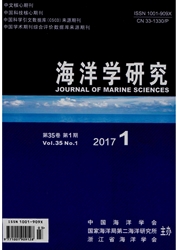

 中文摘要:
中文摘要:
应用改进的三维数值模式,研究了长江河口北支倒灌盐通量。当径流量取11 000 m3/s,风况取风速为6 m/s的北风时,长江河口北支上段大潮、中潮、小潮和半月平均盐通量分别为-26.28,-14.65,-1.58和-15.83 t/s,发生北支盐分倒灌进入南支,大潮期间的盐分倒灌量远大于小潮期间。通过数值计算定量分析了径流量、潮汐和风况对北支倒灌盐通量的影响:枯季北支盐分倒灌随径流量增加而减弱、减小而增强,随潮汐减弱而减小、增强而增加,随北风风应力增强而增加、减弱而减小。计算分析了1998—1999年冬季长江河口北支日均盐通量可知,在径流量小和潮汐强的情况下发生严重的北支盐分倒灌,量值达到-37 t/s。从长江河口北支盐通量时间变化过程看,在季节时间尺度上盐通量主要决定于径流量,从半月时间尺度上大、小潮起着主要作用。
 英文摘要:
英文摘要:
The salt flux from the North Branch into the South Branch in Changjiang River Estuary was studied with the improved 3-D numerical model.In case of 11 000 m3/s river runoff and 6 m/s north wind,the net salt fluxes at the upper reaches of the North Branch during spring,moderate and neap tides and the half month averaged are-26.28,-14.65,-1.58 and-15.83 t/s respectively,which means that the net salt flux is from the North Branch into the South Branch,and this salt flux downdraught is much greater during spring tide than during neap tide.The impacts of runoff,tide and wind stress on the net salt flux from the North Branch into the South Branch were calculated numerically and analyzed quantitatively,which shows that the net salt flux from the North Branch into the South Branch decreases with the increase of runoff and increase with the decrease of the runoff;becomes larger with greater tide and smaller with weaker tide,and increases with increasing wind stress and decreases with decreasing wind stress.The daily mean salt flux at the upper reaches of the North Branch in winter of 1998—1999 was calculated and analyzed,which shows that in case of low runoff and strong tide,severe downdraught of salt flux from the North Branch into the South Branch has happened,which reached-37 t/s.In view of the temporal variation of the net salt flux,it is determined mainly by the river runoff at the seasonal time scale,and mainly by spring-neap tide at the half-moon time scale.
 同期刊论文项目
同期刊论文项目
 同项目期刊论文
同项目期刊论文
 期刊信息
期刊信息
